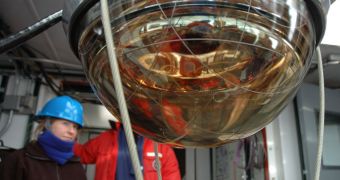A newly-signed contract designated experts at the University of Wisconsin-Madison (UWM) as the main operators of an impressive neutrino telescope, which is buried deep underneath Antarctic ices, near the South Pole.
The group will be managing the impressive IceCube Neutrino Observatory (INO) under a $34.5 million contract that spans 5 years, which was signed together with experts at the US National Science Foundation (NSF).
The telescope is buried under the US Amundsen-Scott South Pole Station, at a depth ranging from 1,400 meters to 2,400 meters. The entire facility is about a cubic kilometer in volume, experts say.
According to the terms of the contract, the UWM group will be in charge of handling the operations of the IceCube, while the NSF will cover them with funds and grants. INO was built to detect and study neutrinos.
These are incredibly difficult-to-detect elementary particles that are generated from a variety of sources, such as the Sun, supernova events in the Milky Way and other galaxies, or when cosmic rays slam into Earth's atmosphere.
They can pass through regular matter unhindered, and carry a neutral electrical charge. This makes them hard to see, but physicists hope that INO will detect the particles as they slam into the atomic nuclei of the frozen ice above the detector.
IceCube is the largest facility of this type ever constructed, and also the most impressive. Its large detector ensures more chances that potential collisions will be observed, although experts say that there are no clear guarantees that will happen.
The project is not exclusively American. Germany, Belgium and Sweden also contributed to its construction, but the UWM group is the main manager of the endeavor. Sine 36 research institutions from around the world are involved in browsing through the data INO collects.
“The IceCube detector is a superb example of the kind of exciting "big science" at the frontiers of knowledge that is ideally suited for support by the US Antarctic Program, precisely because it could be built nowhere else in the world but in the Antarctic ice sheet,” explains Karl A. Erb.
The expert is the director of the NSF Office of Polar Programs (OPP), through which the foundation manages the Antarctic Program. The initiative is responsible for coordinating all the research the US conducts on the Southern Continents and surrounding oceans.
“What's more, although the IceCube project is primarily funded by the National Science Foundation, it exemplifies a modern trend in the increasingly complex and multi-disciplinary scientific world,” the expert adds.
“Large-scale projects like the IceCube detector are too complex to be effectively mounted by one nation alone, but also require the scientific and logistical expertise of many nations acting together to produce scientifically significant results,” he goes on to say.

 14 DAY TRIAL //
14 DAY TRIAL //